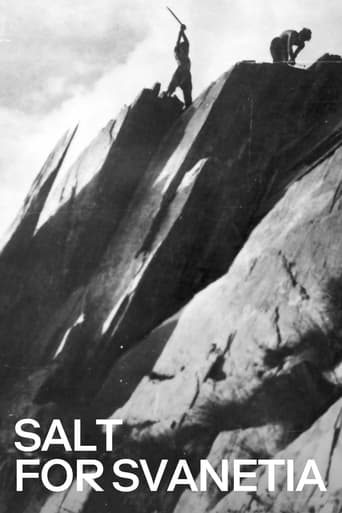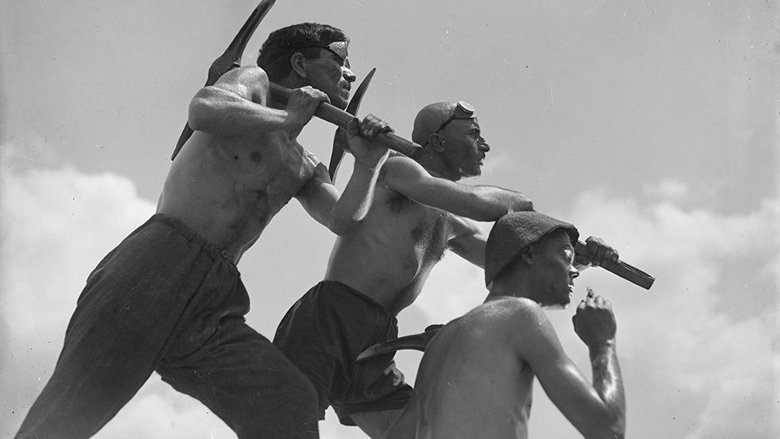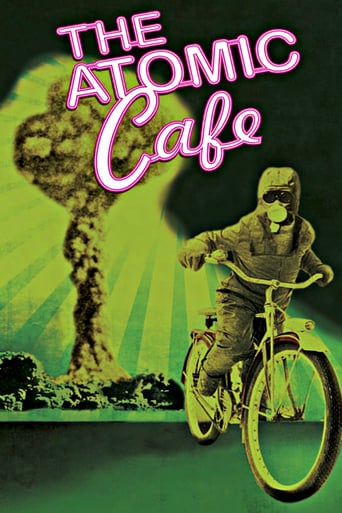

Salt for Svanetia (1973)
An ethnographic treasure that documents with visual bravado the harsh conditions of life in the isolated mountain village of Ushkul.
Watch Trailer
Cast


Similar titles
Reviews
The start of the film gives truly gives an authentic glimpse at a war-torn time in the Soviet Union's history. Many of the techniques used in the film provided for a great production overall. The use of the camera is especially notable. The way that the camera follows the rock down the tower gives the whole starting scene a more dramatic introduction. For the rest of the film shots of the landscape are also noteworthy in their beauty. Not to mention the faces of the villagers who seem rugged with exhaustion. The fact that there were children out working on the fields alongside their mothers is representative of the times. Seeing how the townspeople were able to create so many things out of the wool was inspiring. It was amazing to see what people left to their own undeveloped devices could come up with. Their multiple uses of the abundant stone were resourceful and innovative to say the least. The town practically sustained itself in every sense without the need for technology or outsourcing. It was definitely interesting to see the amount of determination that each town member had. It was definitely insightful considering the religion aspect of it all. The film was very informative and enjoyable to watch because of the way it was set up with its occasional short burst of comedic relief and its ahead of its time editing technique. It is a great film to watch if you would like to get transported into a different world from ours entirely.
Deep in the Caucasian mountains is the region of Svanetia; cut off from civilization by mountains and glaciers. They have snow 8 months out of the year on their mountain pass and thus the Ushkul tribe has remained isolated for centuries, maintaining almost intact their customs and traditions."Jim Shvante" ( Salt For Svanetia ) (1930) was directed by Herr Mikhail Kalatozov and certainly is a brilliant, astonishing Soviet film masterpiece that must be watched by any worthy silent film fan.The film is a semi-documentary about the Ushkul tribe, and their harsh conditions of life in their isolated region. Naturally the communists come to the rescue and provide a brilliant economic plan that brings the region into the twentieth century but of course their way of living and religion must go in the name of progress. It seems that Georgian film directors like Herr Kalatozov (who began his career as a cameraman), had a special fondness for documentaries, giving this film format an excellent opportunity to depict the special idiosyncrasies of the Georgian country."Jim Shvante" makes brilliant use of the camera and has man inventive technical tricks. Of course this is all in the service of propaganda but is aesthetically exciting Every shot in the picture is full of epic atmosphere and of course we have the contrast of Soviet progress and modernity (lots of close-ups of machinery and collective human efforts) with the underdevelopment of the Svans who are being held back by their religion and customs. The film is an inventive mixture of symbolism, ethnography and propaganda.And now, if you'll allow me, I must temporarily take my leave because this German Count must continue his aristocratic isolation from the modern world.Herr Graf Ferdinand Von Galitzien http://ferdinandvongalitzien.blogspot.com/
From the director of The Cranes Are Flying, Letter Never Sent and I Am Cuba, this is Kalatazov's most famous silent film. This is very much Soviet propaganda. It started off as a ethnographic film with a fictional story. The Svans are people of the Caucasus Mountains in Georgia, and they have a very ancient culture. The studio (or perhaps the government) made Kalatazov turn it into a documentary (semi-documentary) about Stalin's Five Year Plan and the way it was bringing backward peoples into modern society. The film ends with a montage on Soviets madly building a highway to Svanetia. Near the beginning of the film, there's some angry finger-pointing at Svanetia's supposedly unfair class system. Besides those injections of propaganda, though, the film is mostly about how difficult surviving in Svanetia is (they can't get salt - that's what the Soviets will bring them!). In that way, it's not unlike Bunuel's Las Hurdes or Shindo's The Naked Island or Flaherty's Man of Aran. While Kalatazov's utterly mad cinematography hadn't quite been perfected yet, the man is still a genius with his images. The montage pounds away violently and leaves you breathless. This should really be included in any list of the great Soviet silents.
So what if it's pure Soviet propaganda...Salt of Svanetia is an amazing looking piece of work that chronicles the hardness of life in the post-Revolutionary expanses of the USSR. There are images in this film you will never see anywhere else...of birth, of work, and of death...all presented bluntly, yet with exquisite artistry .




